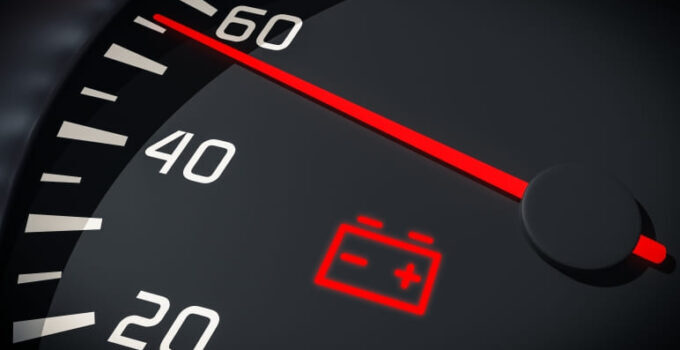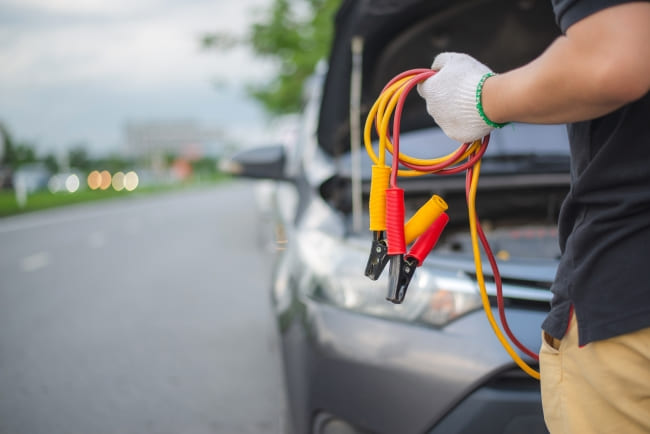
Your car won’t start because your starter battery is dead? We give you help to help yourself so that you can quickly eliminate this annoyance and be on the road again soon. We will also explain what causes a dead car battery and how to eliminate it.
Contents
Car battery dead – signs and causes
You can easily tell that your car battery is empty. A dead starter battery is usually noticeable when you start your engine. If you turn the key in the ignition and hear little or no noise from your starter motor, this may be an indication of a dead battery. However, similar symptoms may also occur due to a defective starter, a broken ignition lock or damaged cable connections. If your starter battery is very deeply discharged, other electrical systems may fail, from the interior lighting to the electronic central locking. The unintentional discharge of your vehicle battery is caused by leakage currents due to defective cables or electrical systems that have continued to run when the engine is switched off (e.g. the vehicle headlights). In addition, the starter battery itself can be defective or it is not charged sufficiently due to an alternator or cable defect. It should also be mentioned that these problems occur more frequently in the cold autumn and winter months because the low temperatures put additional strain on your starter battery.
Your car battery is empty – what can you do do?

There are several ways to test your car battery. If you have a modern charger at hand, you can usually use it to identify a battery defect. First of all, you should fully charge your empty starter battery. If your vehicle still does not start, there is another reason (ignition lock, cable or starter) or your battery is so badly damaged that it must be replaced.
Another possibility is to determine the voltage reached by the starter battery using a simple multimeter. To do this, however, you must first start your car. In the next section we will explain how this is possible with the help of a jump start (because you do not have a suitable charger at hand). Then drive your car a few kilometers or let it idle for about 30 minutes to charge the battery. Then leave your car for a few hours and then measure the battery voltage. This should be in the range of 12.4 to 12.7 V. If this is not the case, either your battery is weak (due to age or an incorrect charging voltage) or there is a consumer or leakage current in your vehicle electrical system.
How can you jump start a vehicle with a dead battery
First of all, you need the right equipment; i.e. suitable jumper cables and a vehicle whose alternator has sufficient power to supply your vehicle with sufficient power. The rule of thumb is that larger/more powerful engines or diesel engines are equipped with alternators with a higher rated output.

The first thing to do is start the engine of the vehicle that is donating the electricity. Then connect the two positive poles of the battery with each other using the red starter cable (it is best to connect the cable to the receiver battery first). Connect one end of the other wire (usually black) to a ground point on your engine or body on the receiving vehicle. This should be as far away from the battery as possible to avoid oxyhydrogen explosions. In the next step, connect the other end of the black starter cable to the negative pole of the power donor battery. Now wait a moment so that the receiver battery can be charged a little. Then try to start your engine. If this does not succeed within 10 seconds, you should wait a little longer. After your vehicle is running, disconnect all connections in reverse order. Drive your car for about 30 minutes, preferably overland, to prepare your battery for the next engine start.
Frequently Asked Questions (FAQ)
⚠ Can you drive with a dead car battery? How long do you have to drive to charge a completely empty starter battery?
If you are able to start your engine (e.g. by jump-starting, as explained above), it is not a problem to drive with this dead battery. On the contrary: In this way you can ensure that your alternator can recharge the empty starter battery. How long you have to drive depends on the route, the alternator performance and the capacity of your battery. As a rule, however, a 30-minute drive should be enough to charge a completely empty starter battery to such an extent that you can start your engine again without jump-starting.
⚠ How long does it take to charge an empty starter battery using a charger?
Again, this depends on the battery capacity, but also on your charger. However, modern chargers are able to automatically switch to trickle charging as soon as the vehicle battery is fully charged. This prevents overloading.
⚠ Where can I hand in or dispose of my old starter battery?
If you first buy a new battery, you have to pay a deposit of currently €7.50. You will get this amount back if you dispose of your old, completely empty starter battery correctly. You can hand them in wherever new batteries are sold, but your local recycling center will also accept them. Please note that the corresponding proof of purchase may be required for the payment of the deposit.
Conclusion
Diagnosing your vehicle battery is not difficult. If your car is regularly parked for a longer period of time, it is advisable to purchase a good charger. This is how you ensure that your starter battery is properly cared for so that it never runs out.
A tip from CarTipsandmore:We recommend that you coordinate the purchase of a new battery and the disposal of your defective component in such a way that you definitely get the battery deposit back. Please keep in mind that an empty car battery must never be disposed of with your household waste. This is partly due to the possible fire hazard and the heavy metals it contains, especially lead.
